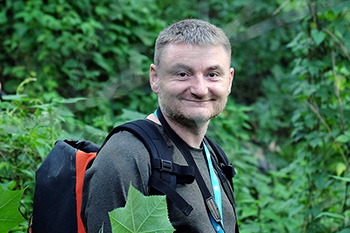Wanted: students to live with monkeys

At LJMU, students of the MSc in Primate Behaviour and Conservation programme are given a once in a lifetime opportunity to venture into the wilds of Tanzania (In the 2017-18 academic year, accommodation and site costs will be covered by LJMU. Students will need to cover some field trip travel costs, primarily the air fare. You may also be required to meet other potential costs, such as field clothing, visas and potential immunisations if needed. In 2015-2016 and 2016-2017 the field trip was in Tanzania.) to study monkeys and apes in their natural habitat with the Greater Mahale Ecosystem Research and Conservation Project (GMERC).
The research project is co-directed by Dr Alex Piel, lecturer in Animal Behaviour, and focuses on primates living in western Tanzania. The region is particularly important as its dry, mosaic environment is similar to what our early ancestors would have lived in. By studying, in particular, the chimpanzees’ adaptations to this environment we can understand our own origins; the apes and the habitat provide a useful model to reconstruct our past.
With it being in an excellent location for studying chimpanzees as well as numerous other species, GMERC gives students the chance to gain experience in remote fieldwork and participate in a range of research and conservation activities: collecting essential data by observing animal behaviour, assessing wildlife abundance and distribution, and monitoring conservation efforts. Surrounded by a spectacular landscape with a diverse array of wildlife, you couldn’t find a more inspiring place to learn.
Still, it’s not for the faint hearted. Situated 70km from the nearest village, the research station is equipped with only the most basic of accommodation (canvas tents, open fire cooking, solar power). Last year’s group had to adapt quickly to ‘getting back to nature’, so not just coping without Facebook, but living without running water, on a limited diet, sleeping in a tent and trudging along difficult terrain. None of this seemed to faze the students as the idea of waking up each day surrounded by wild animals, a breathtaking landscape, friendly people, new experiences and a welcoming camp, outweighed any of the challenges they faced.
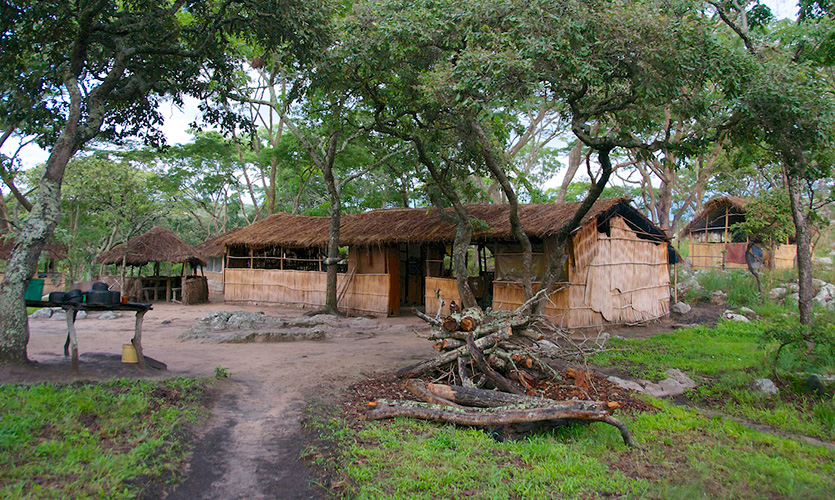
GMERC camp. Credit: GMERC/Marian Polak/Jan Hosek
The students could plan how to spend their days depending on their areas of interests. Some chose to assess botanical diversity close to the station while others made long treks on the trail of monkeys or to look for evidence of illegal poaching. Whatever their particular interests, the students were exposed to the real-world challenges posed by fieldwork and its ability to throw up unexpected outcomes. Being able to roll with the punches will help prepare them for future research challenges.
Simon Stringer was one of the first Liverpool John Moores University students to attend the field course, we found out what made this experience so special.
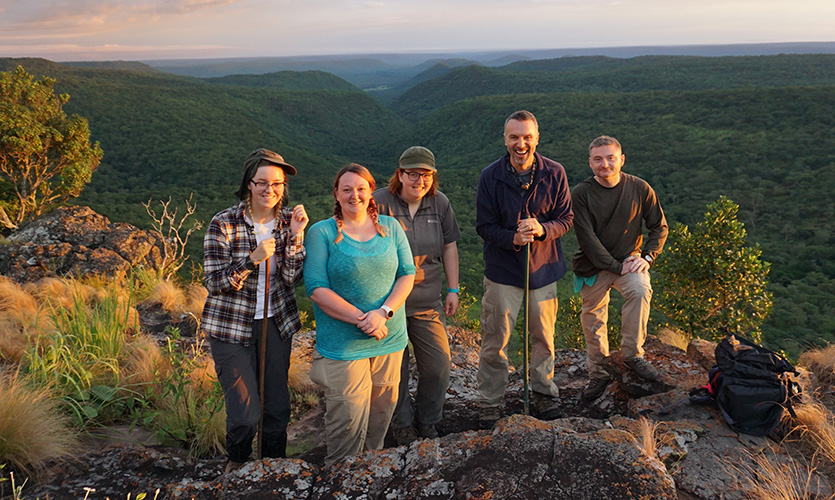
The first LJMU students at GMERC. Simon is on the right next to co-director and LJMU lecturer, Dr Alex Piel.
Simon Stringer talks about his experience
LJMU student Simon Stringer recently took part in the first field studies trip to GMERC as a part of the MSc Primate Behaviour and Conservation programme. We ask Simon about his experiences.
Why did you want to take part in this field trip?
I wanted to use the trip as an exercise of working with small-medium bodied primates, especially as at the time I had applied for a PhD studentship working with similar sized primates in another African country. I also wanted to use the trip to learn from Dr Alex Piel, the trip leader who worked with African primates. The trip was also a chance to visit another country to see and study primates in the field.
Can you describe the setting?
It was very hot with glorious clear skies broken up by the shadows of birds. The sunrise: a breadth of warmth full of oranges, reds, yellows and pinks, raising the morning mist above the trees revealing a magnificent landscape, with forests and mountains stretching as far as the eye could see. Sounds of birds chattering and water rushing through the forest were often broken by screeching apes and chattering monkeys. In camp at night the sky was so very clear that hundreds and hundreds of stars were visible, lighting the void that exists in the ultra-modern metropolis back home. In the evenings the chatter of the researchers, assistants and the cooks around the fire was a welcome end to the day. Everybody was very friendly and happy to help us and show us their beautiful neighbourhood.
Can you describe the conditions of the camp and day-to-day living?
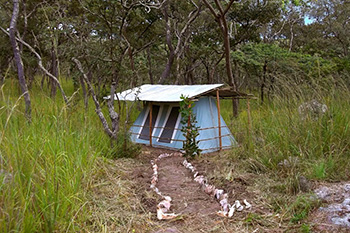 The camp was basic with drop-toilets and a bowl-based washing cubicle. However there was a wonderful river in which to take a cool bath after a hot day’s walking. Breakfast was early, to give us time to reach the monkeys upon their morning stirrings. Food was similar for most meals – beans full of protein to strengthen our aching muscles, cabbage and ugali – a staple maize-based dough-like accompaniment. Our tents were warm with netting to allow for breezes/keep out the flies. The office where we could work was situated at camp’s highest point. Often we saw baboons marching through the miombo woodland below camp.
The camp was basic with drop-toilets and a bowl-based washing cubicle. However there was a wonderful river in which to take a cool bath after a hot day’s walking. Breakfast was early, to give us time to reach the monkeys upon their morning stirrings. Food was similar for most meals – beans full of protein to strengthen our aching muscles, cabbage and ugali – a staple maize-based dough-like accompaniment. Our tents were warm with netting to allow for breezes/keep out the flies. The office where we could work was situated at camp’s highest point. Often we saw baboons marching through the miombo woodland below camp.
What was the hardest thing about the trip?
The hardest thing about the trip were the mountainous walks to reach the monkeys. Both up- and down-hill climbs were exhausting and watching the experienced guides ‘skip’ along made me feel very unfit!
Did you bond with the others on the trip?
Taking part in the activities as a group meant that we bonded over the challenges of navigating the often difficult terrain, while also sharing many first-time experiences – such as seeing a wild chimpanzee.
Can you describe a typical day for you?
The alarm would wake me at 5am when I would get up, dress and pack my bag for the day. Breakfast would be beans and cabbage and we would all meet up around the dining table to discuss the day's plans. By 6am we would leave camp and begin the mountainous trek to reach the monkeys before they woke and left the sleeping site they had been left at the previous night. The day would then be spent following the monkeys as they traversed the forest, recording the data I required for my mini project, stopping for lunch as and when the monkeys stayed put for long enough. The trek back to camp would begin between 4–5pm, and always end in the last up-hill climb to reach the welcoming smell of the campfire and a celebratory dip in the river to wash away the day’s struggles. That gave a few hours to work in the office at the camp’s summit while enjoying the view and listening to the rest of the team’s adventures before the evening meal of beans and cabbage with the occasional treat! At the evening meal we would discuss and plan the next day’s activities once everybody had returned and we learnt where the monkeys had retired for the night. Around 9pm I would retire to my tent to get the next day’s equipment together and read myself to sleep.
What essential items should people bring with them?
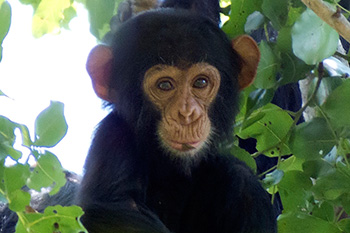 Definitely take a head torch, a good camera and a good pair of binoculars!
Definitely take a head torch, a good camera and a good pair of binoculars!
What was the most memorable thing about your trip?
Seeing the chimpanzee mother with her infant was the most memorable moment for me. While she was quite far away, she knew that we were watching her and that she allowed us to quietly intrude in her life for that short moment was awe inspiring.
Would you recommend the trip or the course to others?
I would recommend both the MSc Primate Behaviour and Conservation course and the trip to future students. The course is delivered by professional, friendly and knowledgeable academics who want you to learn about primatology and current research. Indeed they all have on-going research that they share with you. The course offers excellent facilities for your learning, and of course the chance to learn from leaders in the field. As part of the course, the field trip offers the chance to really put what you have learnt throughout the MSc into practice. The trip accommodates the diversity of people’s fitness and learning styles, as well as encouraging you to work on your own. It also offers the chance to visit Tanzania, and who wouldn’t want to go there.
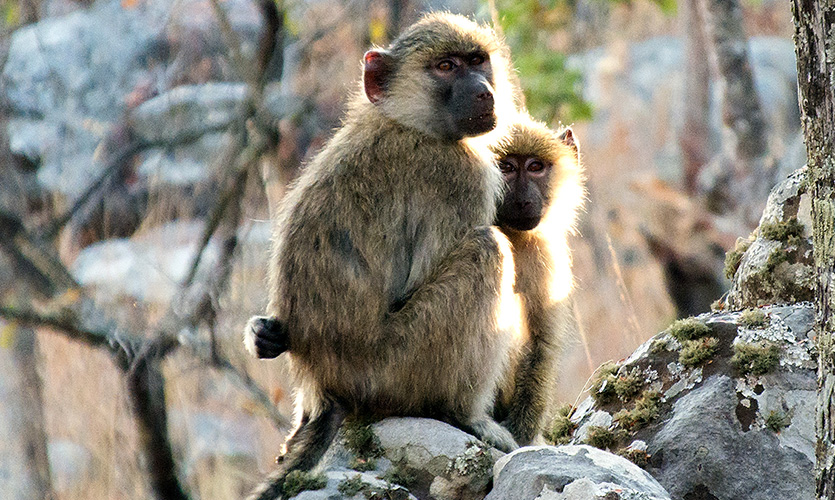
Yellow baboons at GMERC. Credit: GMERC/Ed McLester. (Infant chimpanzee above also GMERC/Ed McLester)
What was the most important thing you learned?
The trip strengthened my passion for research and conservation. Watching the animals interact with their natural habitat and each other reinforced to me the value of conserving forests and other primate habitat, without which we would lose these beautiful, intelligent and important species.
What are your plans for the future?
During my MSc, I applied for and was successful in gaining PhD funding through the AESOP+ Erasmus scheme, which has been match-funded by LJMU. I have now commenced my studies into further research and have left the UK for South Africa to collect my data. The course gave me the skills to apply for the studentship/funding, introduced me to potential supervisors, and gave me the skills to undertake further research and begin my new career in academic research.
Meet Dr Alex Piel and find out more about the project in our feature: The life of a primatologist. Be sure to visit the GMERC website for a wealth of information including images and videos of the wildlife.

